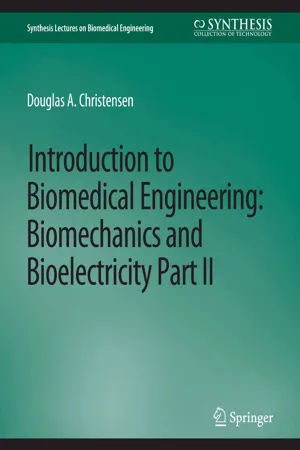
eBook - PDF
Introduction to Biomedical Engineering
Biomechanics and Bioelectricity - Part II
- English
- PDF
- Available on iOS & Android
eBook - PDF
About this book
Intended as an introduction to the field of biomedical engineering, this book covers the topics of biomechanics (Part I) and bioelectricity (Part II). Each chapter emphasizes a fundamental principle or law, such as Darcy's Law, Poiseuille's Law, Hooke's Law, Starling's Law, levers, and work in the area of fluid, solid, and cardiovascular biomechanics. In addition, electrical laws and analysis tools are introduced, including Ohm's Law, Kirchhoff's Laws, Coulomb's Law, capacitors, and the fluid/electrical analogy. Culminating the electrical portion are chapters covering Nernst and membrane potentials and Fourier transforms. Examples are solved throughout the book and problems with answers are given at the end of each chapter. A semester-long Major Project that models the human systemic cardiovascular system, utilizing both a Matlab numerical simulation and an electrical analog circuit, ties many of the book's concepts together. Table of Contents: Ohm's Law: Current, Voltage and Resistance / Kirchhoff's Voltage and Current Laws: Circuit Analysis / Operational Amplifiers / Coulomb's Law, Capacitors and the Fluid/Electrical Analogy / Series and Parallel Combinations / Thevenin Equivalent Circuits / Nernst Potential: Cell Membrane Equivalent Circuit / Fourier Transforms: Alternating Currents (AC)
Frequently asked questions
Yes, you can cancel anytime from the Subscription tab in your account settings on the Perlego website. Your subscription will stay active until the end of your current billing period. Learn how to cancel your subscription.
At the moment all of our mobile-responsive ePub books are available to download via the app. Most of our PDFs are also available to download and we're working on making the final remaining ones downloadable now. Learn more here.
Perlego offers two plans: Essential and Complete
- Essential is ideal for learners and professionals who enjoy exploring a wide range of subjects. Access the Essential Library with 800,000+ trusted titles and best-sellers across business, personal growth, and the humanities. Includes unlimited reading time and Standard Read Aloud voice.
- Complete: Perfect for advanced learners and researchers needing full, unrestricted access. Unlock 1.4M+ books across hundreds of subjects, including academic and specialized titles. The Complete Plan also includes advanced features like Premium Read Aloud and Research Assistant.
We are an online textbook subscription service, where you can get access to an entire online library for less than the price of a single book per month. With over 1 million books across 1000+ topics, we’ve got you covered! Learn more here.
Look out for the read-aloud symbol on your next book to see if you can listen to it. The read-aloud tool reads text aloud for you, highlighting the text as it is being read. You can pause it, speed it up and slow it down. Learn more here.
Yes! You can use the Perlego app on both iOS or Android devices to read anytime, anywhere — even offline. Perfect for commutes or when you’re on the go.
Please note we cannot support devices running on iOS 13 and Android 7 or earlier. Learn more about using the app.
Please note we cannot support devices running on iOS 13 and Android 7 or earlier. Learn more about using the app.
Yes, you can access Introduction to Biomedical Engineering by Douglas Christensen in PDF and/or ePUB format, as well as other popular books in Technology & Engineering & Biophysics. We have over one million books available in our catalogue for you to explore.
Information
Table of contents
- Cover
- Copyright Page
- Title Page
- Dedication
- Contents
- Preface
- Ohm's Law: Current, Voltage and Resistance
- Kirchhoff's Voltage and Current Laws: Circuit Analysis
- Operational Amplifiers
- Coulomb's Law, Capacitors and the Fluid/Electrical Analogy
- Series and Parallel Combinations of Resistors and Capacitors
- Thevenin Equivalent Circuits and First-Order (RC) Time Constants
- Nernst Potential: Cell Membrane Equivalent Circuit
- Fourier Transforms: Alternating Currents (AC) and the Frequency Domain
- Major Project